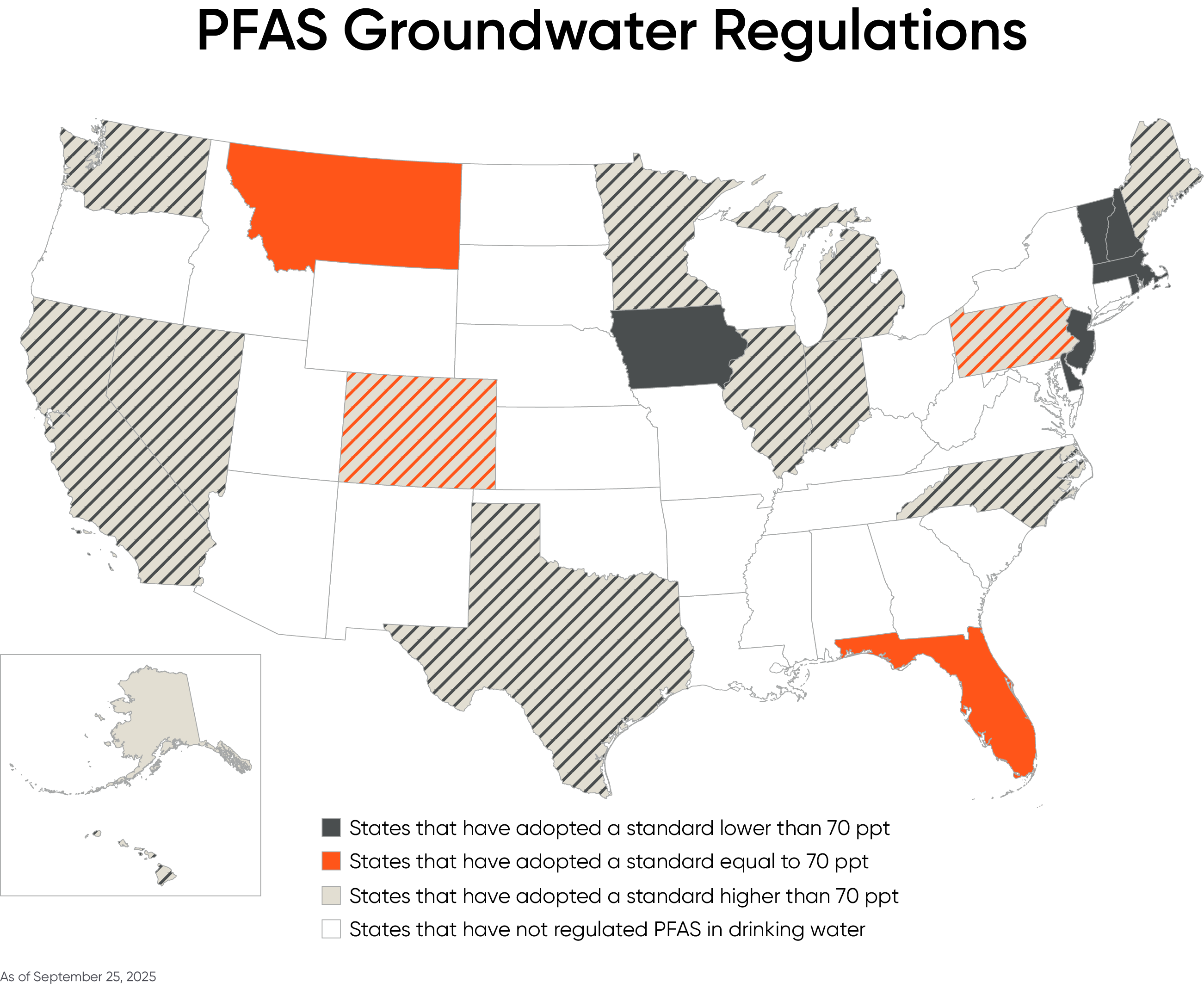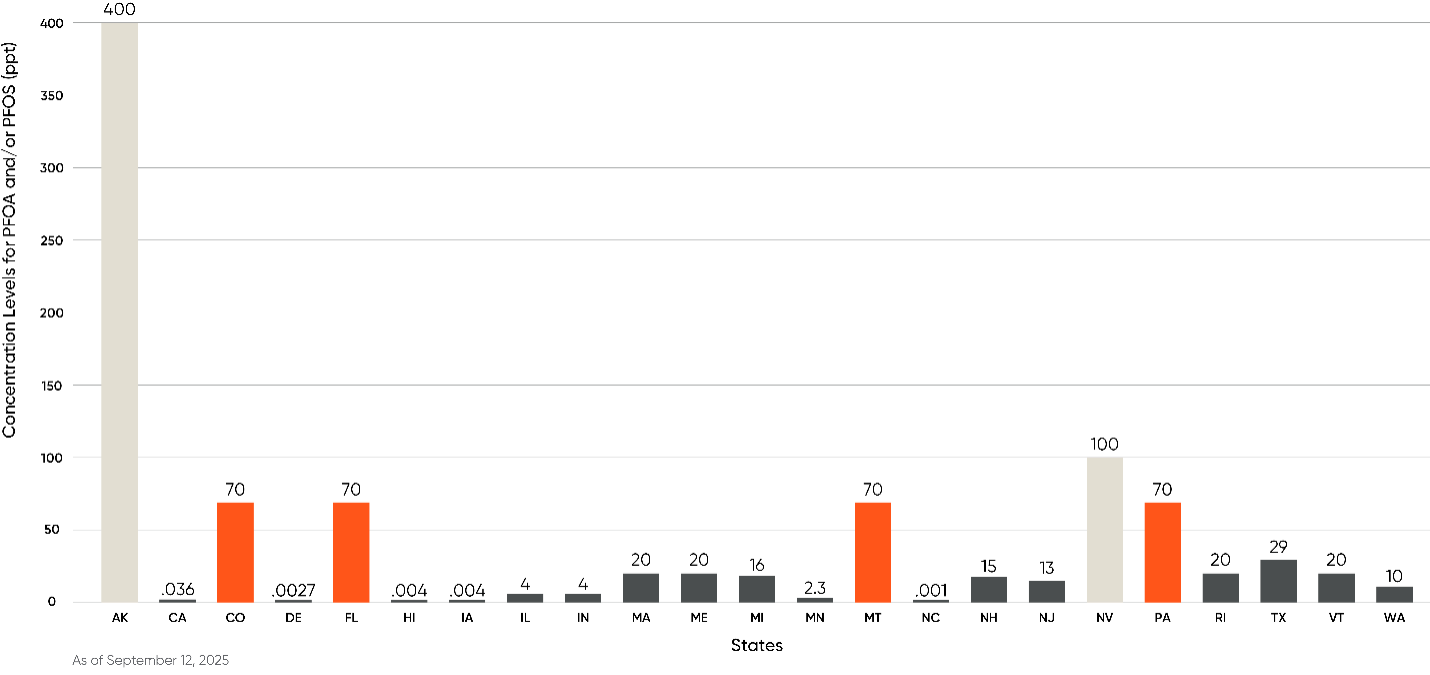Insights
PFAS in groundwater: state-by-state regulations
Updated: September 2025
Sep 25, 2025Summary
In the absence of federal cleanup standards for per- and polyfluoroalkyl substances (“PFAS”) in groundwater, several states have started the process of regulating PFAS in groundwater themselves. As a result, states have adopted a patchwork of regulations and guidance standards that present significant compliance challenges to impacted industries. This client alert explores the current landscape of state regulations regarding the advisory, notification, and cleanup levels for PFAS – typically perfluorooctane sulfonic acid (“PFOS”) and perfluorooctanoic acid (”PFOA”) – in groundwater.
Federal Regulations
In 2019, the United States Environmental Protection Agency (“EPA”) issued interim recommendations to address groundwater contaminated with PFOA and PFOS, but that guidance was subsequently rescinded. Although EPA concluded that the interim recommendation “no longer reflects the best, currently available science,” the fact sheet discussing the 2019 interim recommendations is still a helpful resource to understand how EPA was evaluating the issue at that time.
With respect to PFAS substances in drinking water, in May 2025, EPA affirmed Maximum Contaminant Levels (“MCLs”) of 4 parts per trillion (“ppt”) for two PFAS substances, PFOA and PFOS. For additional information regarding the drinking water standards, refer to BCLP’s recent insight. As of the date of publication, it is unclear how the PFAS drinking water standards will influence any federal PFAS groundwater standards.
State Regulations
The snapshot provided below is current as of September 12, 2025, but it is important to note that this is a developing regulatory space. Some states, such as Florida, have indicated that they will revise groundwater regulations for various PFAS substances that may take effect soon. Other states, such as Arizona, have proposed bills addressing groundwater remediation; other states, such as Illinois, have enacted bills requiring the creation of MCLs in the future.
Businesses should consider whether they currently use or discharge any PFAS compounds that may reach groundwater and evaluate if any state regulations apply, particularly if they operate in any of the jurisdictions listed below. In addition, owners of property with legacy PFAS use, and prospective purchasers of commercial and industrial properties, should review the most current groundwater quality standards as part of the due diligence process for real property transactions.
The information provided below is solely focused on groundwater regulations and does not discuss drinking water regulations, sampling protocols, or the testing requirements for Public Water Systems in various states.

States that have adopted a standard lower than 70 ppt |
Concentration Level
0.036 ppt (stated in the table as 0.000036 µg/L)
Type of Regulation
PFOA (Advisory)
Information
Environmental Screening Level Summary Tables and Related Information
Concentration Level
0.07 ppt (stated in the table as 0.0007 µg/L)
Type of Regulation
PFOS (Advisory)
Information
Environmental Screening Level Summary Tables and Related Information
Concentration Level
0.04 ppt (stated in the table as 0.0004 µg/L)
Type of Regulation
PFDA (Advisory)
Information
Environmental Screening Level Summary Tables and Related Information
Concentration Level
0.0027 ppt, etc. (stated by the Delaware Department of Natural Resources and Environmental Control as 0.0000027 µg/L)
Type of Regulation
PFOA; 12 other PFAS substances (Advisory)
Delaware has 13 PFAS regulations, including the following: PFOA (0.2 ppt); HFPO-DA (1.5 ppt); PFNA (5.9 ppt); PFHxS (10 ppt); PFDoDA (100 ppt); TFSI (590 ppt); PFBS and PFUDA (600 ppt); PFHxA (610 ppt); PFPrA (980 ppt); PFBA (1,800 ppt); PFTetDA (2,000 ppt); and PFODA (80,000 ppt).
Information
Hazardous Substance Cleanup Act Screening Level Table Guidance
Concentration Level
.004 ppt, etc.
Type of Regulation
PFOA and PFOS; 23 other PFAS substances (Advisory)
Hawaii has 25 PFAS regulations, including the following: PFDA (.0077 µg/L); PFNA, HFPO-DA, and PFHxS (.01 µg/L); PFUnDA (.019 µg/L); PFDoDA and PFTrDA (.026 µg/L); PFHpS and PFDS (.038 µg/L); PFOSA (.046 µg/L); PFPrA (.051 µg/L); PFHpA (.077 µg/L); PFTeDA (0.26 µg/L); PFPeS (0.62 µg/L); ADONA (1.2 µg/L); 6:2 FTS and PFPeA (1.5 µg/L); PFHxA and 6:2 FTTAoS (1.9 µg/L); PFBS (2.0 µg/L); 8:2 FTOH (4.2 µg/L); 6:2 FTOH (5.0 µg/L); and PFBA (15 µg/L).
Information
Environmental Action Levels (pg. 71)
Concentration Level
2 ppt (stated by the Illinois Pollution Control Agency as 2 ng/L). There is a health-based guidance level of 0.6 ppt.
Type of Regulation
PFOA (Advisory)
Information
Regulation and related information
Concentration Level
14 ppt (stated by the Illinois Pollution Control Agency as 14 ng/L)
Type of Regulation
PFOS (Advisory)
Information
Regulation and related information
Concentration Level
21 ppt (stated by the Illinois Pollution Control Agency as 21 ng/L)
Type of Regulation
PFNA (Advisory)
Information
Concentration Level
40 ppt (stated by the Indiana Department of Environmental Management as 0.04 µg/L)
Type of Regulation
PFOS (Advisory)
Information
Screening and closure level tables and related information
Concentration Level
60 ppt (stated by the Indiana Department of Environmental Management as 0.06 µg/L)
Type of Regulation
PFOA and PFNA (Advisory)
Information
Concentration Level
0.000014 ppt for protected groundwater sources (stated by the Iowa Department of Natural Resources as 0.000000014 mg/L)
Type of Regulation
PFDA (Advisory)
Information
Statewide Standards and related information
Concentration Level
0.004 ppt for protected groundwater sources (stated by the Iowa Department of Natural Resources as 0.000004 mg/L)
Type of Regulation
PFOS and PFOA (Advisory)
Information
Statewide standards and related information
Concentration Level
0.01 ppt for protected groundwater sources (stated by the Iowa Department of Natural Resources as 0.00001 mg/L)
Type of Regulation
PFHxS and PFNA (Advisory)
Information
Statewide standards and related information
Concentration Level
2 ppt for protected groundwater sources (stated by the Iowa Department of Natural Resources as 0.002 mg/L)
Type of Regulation
PFBS (Advisory)
Information
Statewide standards and related information
Concentration Level
3.5 ppt for protected groundwater sources (stated by the Iowa Department of Natural Resources as 0.0035 mg/L)
Type of Regulation
PFHxA (Advisory)
Information
Statewide standards and related information
Concentration Level
7 ppt for protected groundwater sources (stated by the Iowa Department of Natural Resources as 0.007 mg/L)
Type of Regulation
PFBA (Advisory)
Information
Concentration Level
20 ppt
Type of Regulation
6 PFAS Substances combined: PFOS + PFOA + PFHpA + PFNA + PFHxS and PFDA (Advisory)
Information
Remedial Action Guidelines (pgs. 35-36) and related information
Concentration Level
40 ppt (stated by the Maine Department of Environmental Protection as 0.04 µg/L)
Type of Regulation
PFOS (Advisory)
Note: Maine has both residential and construction standards
Information
Remedial Action Guidelines (pg. 65) and related information
Concentration Level
59 ppt (stated by the Maine Department of Environmental Protection as 0.059 µg/L)
Type of Regulation
PFNA (Advisory)
Note: Maine has both residential and construction standards
Information
Remedial Action Guidelines (pg. 65) and related information
Concentration Level
60 ppt (stated by the Maine Department of Environmental Protection as 0.06 µg/L)
Type of Regulation
PFOA and HPFO-DA (Advisory)
Note: Maine has both residential and construction standards
Information
Remedial Action Guidelines (pg. 63) and related information
Concentration Level
20 ppt (stated in the regulation as .02 ppb)
Type of Regulation
6 PFAS Substances combined: PFOA, PFOS, PFHxS, PFNA, PFHpA, and PFDA (Clean Up)
Information
Concentration Level
6 ppt
Type of Regulation
PFNA (Clean Up)
Information
Regulation and related information
Concentration Level
8 ppt
Type of Regulation
PFOA (Clean Up)
Information
Regulation and related information
Concentration Level
16 ppt
Type of Regulation
PFOS (Clean Up)
Information
Regulation and related information
Concentration Level
51 ppt
Type of Regulation
PFHxS (Clean Up)
Information
Concentration Level
2.3 ppt (stated by the Minnesota Department of Health as 0.023 ppb)
Type of Regulation
PFOS (Advisory)
Information
Health Advisory Level and related information
Concentration Level
35 ppt
Type of Regulation
PFOA (Advisory)
Information
Health Advisory Level (see page 181) and related information
Concentration Level
47 ppt
Type of Regulation
PFHxS (Advisory)
Information
Health Advisory Level (see page 180) and Related Information
Concentration Level
11 ppt
Type of Regulation
PFNA (Clean Up)
Information
Regulation and related information
Concentration Level
12 ppt
Type of Regulation
PFOA (Clean Up)
Information
Regulation and related information
Concentration Level
15 ppt
Type of Regulation
PFOS (Clean Up)
Information
Regulation and related information
Concentration Level
18 ppt
Type of Regulation
PFHxS (Clean Up)
Information
Concentration Level
2 ppt (stated by the regulation as 0.002 µg/L)
Type of Regulation
Chloroperfluoropolyether carbonates (Clean Up)
According to a publication from the New Jersey Department of Environmental Protection, chloroperfluoropolyether carbonates (“ClPFPECAs”) have been used as processing aids, usually in food processing equipment or food contact articles.
Information
Interim Specific Groundwater Quality Criterion and related information
Concentration Level
2.1 ppt (stated by the regulation as 0.0021 µg/L)
Type of Regulation
Perfluoropolyether dicarboxylates (Clean Up)
According to a publication from the New Jersey Department of Environmental Protection, Perfluoropolyether Dicarboxylates (“PFPE-DCAs”) have been used as processing aids, especially as an oil and water repellent in the manufacture of food-contact paper and paperboard.
Information
Interim Specific Groundwater Quality Criterion and Related Information
Concentration Level
13 ppt
Type of Regulation
PFNA and PFOS (Clean Up)
Information
Regulation and related information
Concentration Level
14 ppt
Type of Regulation
PFOA (Clean Up)
Information
Regulation and related information
Concentration Level
20 ppt (stated in the regulation as .02 µg/L)
Type of Regulation
HFPO-DA and Gen X (Clean Up)
Information
Interim Specific Ground Water Quality Criterion and related information
Concentration Level
66.7 ppt (stated in the regulation as 0.0667 µg/L)
Type of Regulation
PFSA (Advisory)
Information
Concentration Level
0.001 ppt (stated by North Carolina Environmental Quality as 0.001 ng/L)
Type of Regulation
PFOA (Clean Up)
Information
Interim Maximum Allowable Concentration and related information
Concentration Level
0.7 ppt (stated by North Carolina Environmental Quality as 0.7 ng/L)
Type of Regulation
PFOS (Clean Up)
Information
Interim Maximum Allowable Concentration and related information
Concentration Level
10 ppt (stated by North Carolina Environmental Quality as 10 ng/L)
Type of Regulation
HFPO-DA, PFNA, PFHxS (Clean Up)
Information
Interim Maximum Allowable Concentration and related information
Concentration Level
20 ppt (stated in the regulation as 20 ng/L)
Type of Regulation
6 PFAS Substances combined: PFOS, PFOA, PFNA, PFDA, PFHxS, PFHpA (Notification)
Information
Concentration Level
29 ppt, etc. (stated by the Texas Commission of Environmental Quality as 0.029 mg/L)
Type of Regulation
PFOA; 16 Different PFAS Substances (Clean Up)
Texas has 16 regulations, including the following: PFHxS (9.3 ppt); PFOA, PFNA, PFDS, PFUndA, PFOSA, PFTrDA, PFTeA, and PFDoA (29 ppt); PFDA (37 ppt); PFOS and PFHpA (56 ppt); PFHxA and PFPeA (1,200 ppt); PFBA (2,400 ppt); and PFBS (3,400 ppt).
Information
Protective Concentration Levels (see February 2025 Tier 1 PCL Table)
Concentration Level
20 ppt (stated in the regulation as .02 µg/L)
Type of Regulation
5 PFAS substances combined: PFHpA, PFHxS, PFNA, PFOS and PFOA (Notification)
Information
Concentration Level
9 ppt (stated by the Washington Department of Ecology as 9 ng/L)
Type of Regulation
PFNA (Advisory)
Information
Concentration Level
10 ppt (stated by the Washington Department of Ecology as 10 ng/L)
Type of Regulation
PFOA (Advisory)
Information
Concentration Level
15 ppt (stated by the Washington Department of Ecology as 15 ng/L)
Type of Regulation
PFOS (Advisory)
Information
Concentration Level
24 ppt (stated by the Washington Department of Ecology as 24 ng/L)
Type of Regulation
HFPO-DA or GenX (Advisory)
Information
Concentration Level
65 ppt (stated by the Washington Department of Ecology as 65 ng/L)
Type of Regulation
PFHxS (Advisory)
Information
States that have adopted a standard equal to 70 ppt |
Concentration Level
70 ppt
Type of Regulation
Site-specific Standard for PFOA and PFOS (Clean Up)
Information
Site-Specific Groundwater Quality Standard (pg. 12)
Concentration Level
70 ppt (stated in the regulation as 70 ng/L)
Type of Regulation
3 PFAS substances combined: PFOS, PFOA, and PFNA (Guidance)
Information
Concentration Level
70 ppt
Type of Regulation
PFOS and PFOA combined (Advisory)
Information
Health Advisory Level and PFAS Dynamic Plan (pg. 9)
Concentration Level
70 ppt
Type of Regulation
PFOS and PFOA combined (Potential Clean Up)
Information
Numeric Water Quality Standard (pg. 60) and related information
Concentration Level
70 ppt
Type of Regulation
PFOS and PFOA combined (Potential Clean Up)
Information
Medium Specific Concentration Cleanup Standards and related information
States that have adopted a standard higher than 70 ppt |
Concentration Level
400 ppt (stated in the regulation as 0.4 µg/L)
Type of Regulation
PFOA and PFOS separately (Clean Up)
Information
Regulation (18 AAC Ch. 75, Table C) and Related Information
Concentration Level
200 ppt (stated in the table as 0.2 µg/L)
Type of Regulation
PFPrA (Advisory)
Information
Environmental Screening Level Summary Tables and Related Information
Concentration Level
500 ppt (stated in the table as .5 µg/L)
Note: There is a Hazard Index calculation that is < 1 for a mixture of two or more of these 4 PFAS substances: PFNA, PFHxS, HFPO-DA, and PFBS
Type of Regulation
PFBS (Advisory)
Information
Environmental Screening Level Summary Tables, Environmental Screening Levels User Guide (See Sec. 3.6.6), and Related Information
Concentration Level
1,000 ppt (stated in the table as 1 µg/L)
Type of Regulation
PFDoDA (Advisory)
Information
Environmental Screening Level Summary Tables and Related Information
Concentration Level
6,000 ppt (stated in the table as 6 µg/L)
Type of Regulation
PFUDA (Advisory)
Information
Environmental Screening Level Summary Tables and Related Information
Concentration Level
9,900 ppt (stated in the table as 9.9 µg/L)
Type of Regulation
PFHxA (Advisory)
Information
Environmental Screening Level Summary Tables and Related Information
Concentration Level
18,000 ppt (stated in the table as 18 µg/L)
Type of Regulation
PFBA (Advisory)
Information
Environmental Screening Level Summary Tables and Related Information
Concentration Level
20,000 ppt (stated in the table as 20 µg/L)
Type of Regulation
PFTeDA (Advisory)
Information
Environmental Screening Level Summary Tables and Related Information
Concentration Level
24,000 ppt (stated in the table as 2.4 µg/L)
Type of Regulation
PFODA (Advisory)
Information
Environmental Screening Level Summary Tables and Related Information
Concentration Level
140,000 ppt (stated in the table as 140 µg/L)
Type of Regulation
PFPeA (Advisory)
Information
Environmental Screening Level Summary Tables and Related Information
Concentration Level
700 ppt (stated in the regulation as 700 ng/L)
Type of Regulation
PFHxS (Guidance)
Information
Concentration Level
400,000 ppt (stated in the regulation as 400,000 ng/L)
Type of Regulation
PFBS (Guidance)
Information
CONCENTRATION LEVEL
140 ppt (stated by the Illinois Pollution Control Agency as 140 ng/L)
Type of Regulation
PFHxS (Advisory)
Information
Regulation and related information
CONCENTRATION LEVEL
2,100 ppt (stated by the Illinois Pollution Control Agency as 2,100 ng/L)
Type of Regulation
PFBS (Advisory)
Information
Regulation and related information
CONCENTRATION LEVEL
3,500 ppt (stated by the Illinois Pollution Control Agency as 3,500 ng/L)
Type of Regulation
PFHxA (Advisory)
Information
Regulation and related information
CONCENTRATION LEVEL
7,000 ppt (stated by the Illinois Pollution Control Agency as 7,000 ng/L)
Type of Regulation
PFBA (Advisory)
Information
Concentration Level
1,000 ppt (stated by the Indiana Department of Environmental Management as 1 µg/L)
Type of Regulation
PFDoDA (Advisory)
Information
Screening and Closure Level Tables and Related Information
Concentration Level
6,000 ppt (stated by the Indiana Department of Environmental Management as 6 µg/L)
Type of Regulation
PFUDA and PFBS (Advisory)
Information
Screening and Closure Level Tables and Related Information
Concentration Level
10,000 ppt (stated by the Indiana Department of Environmental Management as 10 µg/L)
Type of Regulation
PFHxA and PFPrA (Advisory)
Information
Screening and Closure Level Tables and Related Information
Concentration Level
20,000 ppt (stated by the Indiana Department of Environmental Management as 20 µg/L)
Type of Regulation
PFTeTA and PFBA (Advisory)
Information
Screening and Closure Level Tables and Related Information
Concentration Level
800,000 ppt (stated by the Indiana Department of Environmental Management as 800 µg/L)
Type of Regulation
PFODA (Advisory)
Information
Concentration Level
7,000 ppt for protected groundwater sources (stated by the Iowa Department of Natural Resources as 0.007 mg/L)
Type of Regulation
PFBA (Advisory)
Information
Concentration Level
390 ppt (stated by the Maine Department of Environmental Protection as 0.39 µg/L)
Type of Regulation
PFHxS (Advisory)
Note: Maine has both residential and construction standards
Information
Remedial Action Guidelines (pg. 65) and related information
Concentration Level
6,000 ppt (stated by the Maine Department of Environmental Protection as 6 µg/L)
Type of Regulation
PFBS (Advisory)
Note: Maine has both residential and construction standards
Information
Remedial Action Guidelines and related information
Concentration Level
9,900 ppt (stated by the Maine Department of Environmental Protection as 9.9 µg/L)
Type of Regulation
PFHxA (Advisory)
Note: Maine has both residential and construction standards
Information
Remedial Action Guidelines (pg. 65) and related information
Concentration Level
19,000 ppt (stated by the Maine Department of Environmental Protection as 19 µg/L)
Type of Regulation
PFBA (Advisory)
Note: Maine has both residential and construction standards
Information
Remedial Action Guidelines (pg. 65) and related information
Concentration Level
370 ppt
Type of Regulation
HFPO-DA (Clean Up)
Information
Regulation and related information
Concentration Level
420 ppt
Type of Regulation
PFBS (Clean Up)
Information
Regulation and related information
Concentration Level
400,000 ppt
Type of Regulation
PFHxA (Clean Up)
Information
Concentration Level
2,000 ppt
Type of Regulation
PFBS (Advisory)
Information
Health Advisory Level (see pg. 180) and related information
Concentration Level
7,000 ppt
Type of Regulation
PFBA (Advisory)
Information
Health Advisory Level (see pg. 180) and related information
Concentration Level
100 ppt (stated in the regulation as 0.1 µg/L)
Type of Regulation
PFOA (Advisory)
Information
Basic Comparison Levels and related information
Concentration Level
10,000 ppt (stated in the regulation as 10 µg/L)
Type of Regulation
PFBS (Advisory)
Information
Concentration Level
2,000 ppt (stated by North Carolina Environmental Quality as 2,000 ng/L)
Type of Regulation
PFBS (Clean Up)
Information
Interim Maximum Allowable Concentration and related information
Concentration Level
4,000 ppt (stated by North Carolina Environmental Quality as 4,000 ng/L)
Type of Regulation
PFHxA (Clean Up)
Information
Interim Maximum Allowable Concentration and related information
Concentration Level
7,000 ppt (stated by North Carolina Environmental Quality as 7,000 ng/L)
Type of Regulation
PFBA (Clean Up)
Information
Interim Maximum Allowable Concentration and related information
Concentration Level
10,000 ppt (stated in the regulation as 10 µg/L)
Type of Regulation
PFBS Residential Property (Clean Up)
Information
Medium-Specific Concentration Standards and related information
Concentration Level
29,000 ppt (stated in the regulation as 29 µg/L)
Type of Regulation
PFBS Non-residential Property (Clean Up)
Information
Medium-Specific Concentration Standards and related information
Concentration Level
345 ppt (stated by the Washington Department of Ecology as 345 ng/L)
Type of Regulation
PFBS (Advisory)
Information
Related information |
*at date of publication
- Alabama
- Arizona
- Arkansas
- Connecticut
- Georgia
- Idaho
- Kansas
- Kentucky
- Louisiana
- Maryland
- Mississippi
- Missouri
- Nebraska
- New Mexico
- New York
- North Dakota
- Ohio
- Oklahoma
- Oregon
- South Carolina
- South Dakota
- Tennessee
- Utah
- Virginia
- West Virginia
- Wisconsin
- Wyoming
Notification
A corporate representative must inform the appropriate state official that the groundwater is above the stated limit.
Advisory
These levels are not binding limits, but they can serve as the basis for regulatory action, and are a useful tool for due diligence and risk assessment.
Clean Up
Investigation and remediation is usually required when concentration levels exceed the clean up threshold. This is usually expressed by groundwater quality standards that identify specific clean up criteria.
Additional Information
One of the most striking features of the regulatory landscape for PFAS in groundwater is the wide range of regulatory concentration levels. For example, for PFAS substances in groundwater, one of the most stringent concentration limits is 0.000014 ppt (Iowa; PFDA only), and one of the most lenient concentration limits is 870,000 ppt (California; PFHpA only). The following chart demonstrates that even for PFOA and PFOS, which have been more extensively studied and regulated than other PFAS compounds, there is still a wide discrepancy in the values that different states have adopted.

Conclusion
Businesses operating in the states where groundwater regulations have already been enacted should consider whether they currently use or discharge any of the regulated PFAS compounds. In addition, owners of property with legacy PFAS use, and prospective purchasers of commercial and industrial properties in these jurisdictions will increasingly need to incorporate the groundwater quality standards into their due diligence processes.
For more information on PFAS chemicals, and the regulatory and litigation risks that they pose, please visit our PFAS webpage. If you have a question about how to manage PFAS risk in any jurisdiction, contact Tom Lee, Bryan Keyt, Erin Brooks, John Kindschuh, or any other member of our PFAS team at BCLP.
Related Capabilities
-
PFAS
-
Environment





